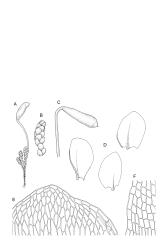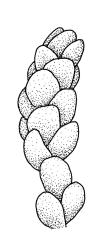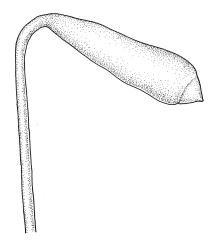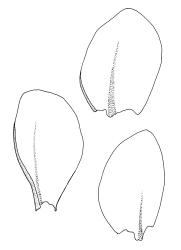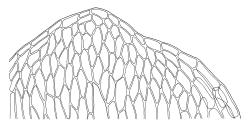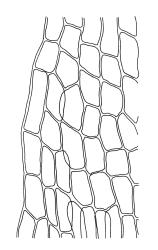Plants whitish or pale brown-green, often tinged with pink below. Stems 3–6 mm, often broken at tips, beset at base with papillose, brown rhizoids, in cross-section with both cortical cells and central strand ill-defined. Leaves ± evenly spaced on stem, imbricate, cochleariform and broadly rounded at apex, c. 0.5–0.7 mm long, often ± pink below, entire, concave, plane at margins, not bordered; upper laminal cells thin-walled, often lacking chlorophyll, 45–75 × 21–30 µm and 1.5–2:1, somewhat smaller at extreme apex, more oblong and slightly firmer-walled in lower leaf; basal cells green or suffused with pink. Costa rather thin, ± pink below, ending far below leaf apex.
Apparently dioicous. Perichaetia in stem axils or near base of plant; perichaetial leaves oblong-lanceolate, 1.3–1.5 mm, recurved at margins. Perigonia terminal, with broadly ovate and acute bracts to 1.4 × 0.8 mm. Setae c. 10–17 mm, pale brown; capsules horizontal or nearly so (but sometimes pendulous when dry), with an oblong, ± gibbous urn and a very long, narrow neck c. ½ the capsule length (poorly illustrated here and best seen in dry material), c. 5–6 mm; operculum mammillate. Exostome teeth nearly smooth, equal or shorter than endostome; endostome with narrow, perforate, lanceolate segments and rudimentary cilia. Spores ± reniform, 27–33 µm diam., brown, papillose, often with trilete scars.
Plagiobryum novae-seelandiae could be confused with Bryum harriottii, although the thinner-walled and larger upper laminal cells, the more delicate leaves, and the very elongate capsules (c. 5–6 mm) of the former provide distinction. Confusion might also occur with sterile B. argenteum, but the features in the key to species, including capsule form and dimensions, clearly differentiate P. novae-seelandiae. Plagiobryum novae-seelandiae is documented only from relatively high elevations, in comparison to the weedy and more widely distributed B. argenteum.
NI: Wellington (NW Ruahine Range); SI: Nelson (Mt Arthur, Mt Owen), Canterbury (Broken River, Bealey River, Godley River), Southland (Takahē Valley).
Endemic.
On humic soil over limestone and marble, in either forest or grassland habitats. Collections from the Bealey River and the Godley River suggest occurrence on greywacke; these collections are probably from base-rich sites. Documented from 790–1650 m. Bryoerythrophyllum recurvirostrum, Distichium capillaceum, and Pohlia cruda are frequently associated.
The vegetative leaves of P. novae-seelandiae are consistently cochleariform and broadly rounded at apices, in contrast to the ± ovate and acute leaves of the widespread northern hemisphere P. zierii (Hedw.) Lindb., which it resembles in capsule form. The differences in leaf form, together with phytogeographic considerations, justify the specific status accorded the N.Z. taxon by Ochi (1970, p.14). Sainsbury’s (1955, p. 265) suggestion that P. novae-seelandiae be reduced to a variety of P. zierii is not followed here. The limited fruiting material available suggests that the capsules may be more pendulous in P. novae-seelandiae.
Poorly documented collections from the Bealey and Godley Rivers have leaves more ovate and more acute than other populations, including the type. Such atypical populations (presumably from areas of greywacke bedrock) deserve closer investigation. Unfortunately, the scant herbarium material lacks capsules. A collection from Bealey River by S. Berggren (WELT M 010129) is the only material in which perigonia have been observed.




